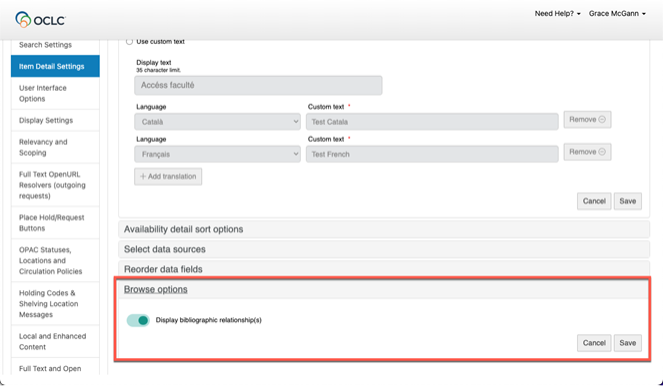WorldCat Discovery release notes 17 July 2024
Release Date: July 17, 2024
Introduction
This release of WorldCat Discovery includes the following enhancements as well as bug fixes:
- For users with group catalog subscriptions, you can now link to items related hierarchically
- Accessibility enhancements for a more inclusive user experience.
Many of these changes are a direct result of your feedback.
New features and enhancements
For users with group catalog subscriptions, you can now link to items related hierarchically
With the 18 March 2024 release, WorldCat Discovery Premium and WMS users were able to access a new experience where they can navigate hierarchically related records in WorldCat Discovery.
With the 17 July release, this feature has been extended to group catalogs.
Relationships in the MARC 773, 800, 810, 811, and 830 fields cataloged using a valid OCLC Control Number (OCN) in the control $w will be represented in this new experience.
You can activate the display of these relationships on the item details page by navigating to Service Configuration > WorldCat Discovery and WorldCat Local > Item Detail Settings > Browse Options.
If a record is cataloged with hierarchical relationships, those relationships can be located at the bottom of the item details page in a new tab called “Browse related items.” This tab will be located with other browse experiences “Browse the Shelf” and “Explore Editions & Formats.” There, users will find links to three possible relationships (when they exist).
These can be thought of as whole-part relationships.
- In: an item is part of another item, like a volume (part) of an encyclopedia (whole).
- Contains: an item contains something else, like an archival collection (whole) contains items (parts).
- Grouped with: multiple items are part of the same whole, as in the previous example, where items that are parts of the same archival collection would fall under this “grouped with” relationship.
Accessibility enhancements for a more inclusive user experience
This release includes two accessibility enhancements as part of our ongoing effort to ensure a more inclusive user experience:
- The contrast ratio of the placeholder text in the global search bar has been enhanced by darkening its color. This adjustment ensures that the new color surpasses the WCAG 2.1 Contrast (Minimum) guidelines to ensure sufficient color contrast.


- The ARIA code for the “Library Name” in the ‘Send Feedback’ form has been updated to provide a better user experience for individuals utilizing assistive technology.
Bug fixes
Links from the A-Z list resolve to an article instead of a journal
In the A-Z platform, article links surfaced from the knowledge base will now direct users to an article. Previously, article links were directing users to a journal.
Links surface on the A-Z list page when navigating from Talis Aspire
When users navigate from their reading lists in Talis to the A-Z platform, knowledge base links will surface for records with matching ISSNs/ISBNs selected in the knowledge base. Previously, links for these resources were not surfacing.
Knowledge base links will no longer surface on article records that fall outside the coverage listed in the knowledge base
Article records viewed in the A-Z platform will now honor the coverage listed in the knowledge base. Links will no longer surface on articles where publication date or enumeration fall outside the coverage listed in the knowledge base. When no publication date/enumeration is available, the A-Z page will continue to surface links.
Important links
Product website
More product information can be found here.
Support website
Support information for this product and related products can be found at:
Include Request ID with problem reports
When reporting an issue with WorldCat Discovery, it is extremely helpful to include the Request ID. The Request ID is found at the bottom of the screen where the issue occurred. Including this information allows us to directly trace what happened on the request we are troubleshooting.



